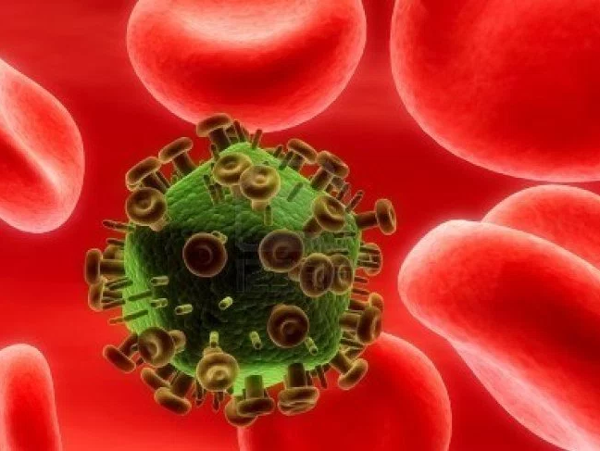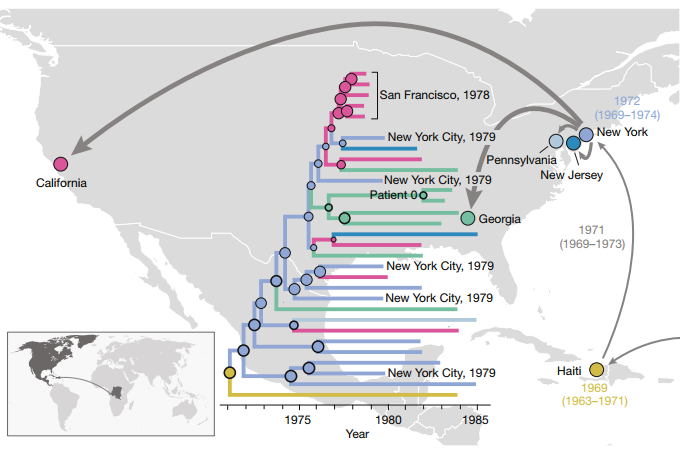HIV in North America
There is a new theory about Patient 0 and the early history of HIV in North America that contradicts the current theory. Scientists have been interested in how HIV has entered certain countries and spread across the globe since it was detected. The current theory is that a person from Africa or Haiti came to North America and spread the virus to people there. Many researchers believe that this individual is Patient 0. However, a new analysis by Michael Worobey and colleagues at the Department of Ecology and Evolutionary Biology at the University of Arizona has been published in the Nature journal that reexamines the early HIV/AIDS history in North America and comes to a different conclusion.
History of HIV in North America
Worobey et al needed to know about both the HIV virus itself and its history to know more about how it was transmitted to North America. The first acknowledgement that HIV was in North America was in 1981 when the CDC published a Morbidity and Mortality Weekly Report. The report stated that the amounts of Pneumocystis Jiroveci Pneumonia and Kaposi Sarcoma in gay men in California and New York was abnormally high. A task force on Kaposi’s Sarcoma and Opportunistic Infections was put together “to identify risk factors and to develop a case definition for national surveillance” (aids.gov). People with these diseases became negatively viewed by the general public, even as far as called these diseases “gay cancer.” In 1982, the CDC first uses the term Acquired Immune Deficiency Syndrome (AIDS) and defines it as a “disease, at least moderately predictive of a defect in cell-mediated immunity, occurring in a person with no known cause for diminished reistance to that disease.” It’s not until 1983 that the major transmission routes of the virus causing AIDS is known and the next year that the virus causing AIDS is discovered, In 1985 blood banks begin screening for this new virus. It isn’t until 1986 that this virus is officially named the Human Immunodeficiency Virus (HIV).

HIV Transmission
HIV is a retrovirus, or a single strand RNA virus that once inside the host cell cytoplasm uses an enzyme and the host cell to produce DNA from its RNA genome. The DNA in then incorporated into the host cell genome and is translated and transcribed by the host cell into proteins that assemble new copies of the virus. These new copies then leave the host cell to infect a new cell to continue the cycle. Ultimately, the HIV virus weakens the immune system by destroying cells that fight disease and infection. There is currently no cure but the virus can be controlled through medication. There are three stages of HIV. The first stage is acute infection, where a person exhibits flu-like symptoms with 2-4 weeks after infection. There are large amounts of virus in the body and these people are very contagious and usually unaware of the infection and vast number of viruses are in the body. These people are very contagious and usually unaware of the infection. Clinical latency, the second stage, is where the HIV virus is dormant but still reproducing at low levels. Infected persons may not have symptoms but they can still transmit the virus to others. At the end of this stage, the number of viruses increases and the number of infection fighting cells decrease. When the number of viruses increases to a certain point and infection fighting cells fall below a certain threshold, the individual has moved into the third stage, AIDS. In this stage, a person is very infectious. Opportunistic infections, or uncommon infections that take advantage of a weakened immune system, are common in individuals with AIDS.
The CDC states that “only certain body fluids (blood, semen, pre-seminal fluid, rectal fluids, vaginal fluids, or breast milk) from a person who has HIV can transmit HIV” and HIV is not transmitted through air, water, saliva, sweat, or tears. To become infected, the particular body fluids of an infected person mentioned above must come in contact with the bloodstream, infected tissue, or mucous membrane of an unaffected person. Mucous membranes are found in the lining of the nose, mouth, airway, esophagus, stomach, intestines, penis or vagina. In the United States, HIV is mostly spread by having sex without a condom and sharing needles or syringes to inject drugs. There are other ways HIV can be transmitted but they are less common.
Patient 0 Controversy

One controversy Worobey et al had to acknowledge was that a majority of researchers believed HIV came to North America because of an individual known as Patient 0. Patient 0, whose real name was Gaetan Dugas, was a homosexual French-Canadian flight attendant. He was part of the study on Kaposi Sarcoma. He admitted to having multiple sexual partners and helped researchers in tracing his network of partners. Dugas was different from other individuals in the study because most individuals could not remember or name their partners while Dugas named approximately fifty of his. Dugas was featured in Randy Shilt’s book And the Band Played On: Politics, People, and the AIDS Epidemic as someone who knowingly and intentionally spread the HIV virus to others. Shilts went as far as to describe him as the Quebecois version of Typhoid Mary. After the book was published, many people believed that Dugas was the source of HIV in North America. He had the means to pick up the virus from another continent because of his profession as a flight attendant. He had the opportunity to spread the virus to his multiple partners in North America. He wasn’t concerned about infecting his partners with the virus. He gained the term “Patient 0” from scientists. As far as people were concerned, Dugas had the motive, means, and opportunity to bring the virus to North America. Worobey et al would have to factor Patient 0 into their experimental designs to either confirm or disprove that idea that he was the source of HIV in North America.
Worobey’s Experiment
Another problem Worobey and his team had to tackle when they were trying to understand where HIV in North America originated was where their evidence was going to come from. It wasn’t until years after people had been dying from AIDS complications that the cause was found to be a virus, later named HIV. Scientists had suggested that HIV was in the US as early as the 1970’s but there was no concrete evidence. How did Worobey et al solve this problem? Armed with the knowledge that AIDS and therefore HIV was mostly found in homosexual males at the beginning of the outbreak, Worobey et al went through over 2,000 blood samples from the 1970’s of men who had sex with men in New York City and San Francisco and screened for the HIV virus. After the HIV virus was extracted, the researchers were able to infer a phylogeny for HIV. In their phylogeny, Worobey et al included the virus from Patient 0.

A case is always stronger when there is more than one type of evidence to corroborate their conclusion. Worobery and his team had the physical evidence of the HIV virus phylogeny. Going back through the research on Kaposi Sarcoma, of which Patient 0 was a participant, Worobey et al were able to find another type of evidence. Dugas was part of a cohort of homosexual men with AIDS linked through sexual contact. He was placed near the center of one sociogram, a graphic representation of social links, and gained the abbreviation Patient O to indicate “Outside of California.” This O was misinterpreted as a zero and the error persisted when the study was published. The original authors acknowledged their mistake and continue to say that Dugas was probably not the source of AIDS for either the cluster he was a part of or the US epidemic. The confusion that Dugas was the source of HIV in North America may have persisted because of the terminology epidemiologists use. The initial patient in an epidemiological investigation, or the first case of a condition to be described, is called the index case, or Patient 0. Index cases may indicate the source and the possible spread of the disease. When Patient O was incorrectly published as Patient 0, epidemiologists assumed Dugas was the source of HIV in North America because of the terminology.
Evidence is nothing if detectives and scientists cannot infer conclusions and communicate them. What did Worobey and his team conclude? They found that the HIV virus came to North America from a preexisting Caribbean epidemic. The first place to be infected in North America was New York City and then the virus dispersed to other places such as California, Pennsylvania, and New Jersey. Worobey et al also found that the virus infecting Patient 0 was not the ancestral strain in North America, but a more recent one, just as previous researchers had said. Their final conclusion was that Gaetan Dugas did not bring the HIV virus to North America.
The work done by Worobey et al is significant because they took speculation of scientists to get biological evidence of the HIV virus stores in forty year old blood samples that then corroborated with historical data of previous researchers. All the evidence came together to tell one story: HIV was transmitted to North America from a previous Caribbean strain around 1972. The virus then spread and Patient 0, Gaetan Dugas, was infected later. There is only one true story. No matter what other people say or claim, evidence only tells the truth. To know it, scientists have to find and listen to it.
References: Worobey, M., Watts, T. D., Mckay, R. A., Suchard, M. A., Granade, T., Teuwen, D. E., . . . Jaffe, H. W. (2016). 1970s and ‘Patient 0’ HIV-1 genomes illuminate early HIV/AIDS history in North America. Nature, 539(7627), 98-101. doi:10.1038/nature19827
This series is supported by NSF Grant #DBI-1356548 to RA Cartwright.
